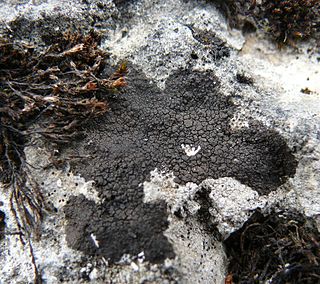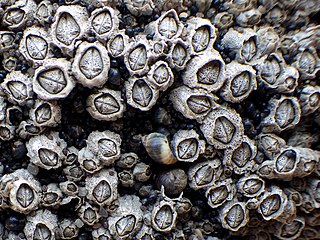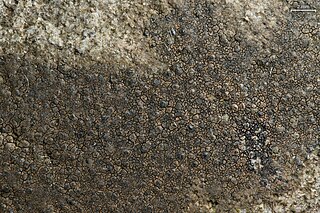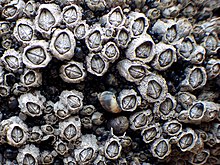
Verrucariaceae is a family of lichens and a few non-lichenised fungi in the order Verrucariales. The lichens have a wide variety of thallus forms, from crustose (crust-like) to foliose (bushy) and squamulose (scaly). Most of them grow on land, some in freshwater and a few in the sea. Many are free-living but there are some species that are parasites on other lichens, while one marine species always lives together with a leafy green alga.

Xanthopyreniaceae is a family of lichen-forming fungi in the order Collemopsidiales. The family was circumscribed by lichenologist Alexander Zahlbruckner in 1926.
Zwackhiomyces is a genus of lichenicolous (lichen-dwelling) fungi in the family Xanthopyreniaceae.

Collemopsidium is a genus of fungi in the family Xanthopyreniaceae. Some members of this genus are marine species, and described as "borderline lichens" or "algicolous" fungi.
Pyrenocollema elegans is a lichen-forming fungus species that grows in marine environments along rocky coastlines. First recognised in 1937 and formally described by the Swedish lichenologist Rolf Santesson in 1992, it is distinguished by its dark brown thallus that forms rosettes up to 10 mm in diameter bearing characteristic black ridges and warts. The species inhabits the intertidal zone, particularly on siliceous rocks, where it commonly associates with barnacles and other marine lichens. It has a wide geographic distribution, occurring along the Atlantic coast of Europe from Norway to northern Spain, and along the Pacific coasts of North and South America. Originally classified under Arthopyrenia, it was later transferred to Pyrenocollema.
Sclerococcum serusiauxii is a species of lichenicolous fungus in the family Dactylosporaceae. It was described as a new species in 1993 by Montserrat Boqueras and Paul Diederich. The type was collected in Col de la Pierre St Martin, at an altitude of 1,550 m (5,090 ft). Here, the fungus was growing on the lichen Parmelina pastillifera, which itself was growing on Pinus uncinata. The specific epithet honours Belgian lichenologist Emmanuël Sérusiaux, who collected the type specimen in 1989. S. serusiauxii has also been recorded from Montenegro.
Schizotrema is a genus of lichen-forming fungi in the family Graphidaceae. The genus was circumscribed in 2009 by Armin Mangold and H. Thorsten Lumbsch.

Willeya is a genus of saxicolous (rock-dwelling), crustose lichens in the family Verrucariaceae. It has 12 species. Most species are found in southeast Asia, although individual representatives are known from Australia, Europe, and North America.

Heteroplacidium compactum is a species of areolate, crustose lichen in the family Verrucariaceae. It has a cosmopolitan distribution. It is a lichenicolous lichen, growing as a facultative parasite on other lichens, typically on non-calcareous rock. It has rod-shaped (bacilliform) conidia measuring 5–7 μm long, and ascospores that are 11–18 by 8–10 μm. Heteroplacidium zamenhofianum is a closely related species distinguished by having perithecia situated in the algal layer, and smaller ascospores with a more narrow ellipsoid shape.
Trimmatothele is a genus of saxicolous (rock-dwelling), crustose lichens in the family Verrucariaceae. It has five species. The genus was formally published by lichenologist Alexander Zahlbruckner in 1903. The type species, Trimmatothele perquisita, was originally collected from Norway by Johannes M. Norman, who placed it in the genus Coniothele in 1868. Diagnostic characteristics of Trimmatothele include a thin thallus with a smooth surface; small perithecia that are partially immersed in the substrata and have an involucrellum; asci that contain multiple ascospores; and small, simple ascospores. Trimmatothele has been described as one of the most poorly known genera of lichens due to the rarity of its species, the few available herbarium specimens, and some missing type specimens.
Septotrapelia multiseptata is a species of bryophilous (moss-dwelling) lichen in the family Byssolomataceae. Found in South Korea, it was formally described as a new species in 2014 by lichenologists André Aptroot and Kwang-Hee Moon. The type specimens were collected by the first author from Mabok-san mountain at altitudes between 200 and 500 m ; there, the lichen was overgrowing mosses that were growing on siliceous rock. It has a thin mottled greyish and olive green thallus covering areas of up to about 15 cm (6 in). The thallus lacks a cortex; rather, it comprises small, irregularly shaped areoles on a somewhat gelatinous crust. The photobiont partner of the lichen is an myrmecioid green alga, which measures 2–4 μm in diameter. Ascospores of the lichen have a long ellipsoid shape, and measure 17–20 by 6.5–7.5 μm. The species epithet multiseptata refers to the 5 or 6 septa that divide the ascospores into chambers.
Splanchnonema lichenisatum is a species of corticolous (bark-dwelling) lichen in the family Pleomassariaceae. Found in Korea, it was formally described as a new species in 2014 by Dutch lichenologist André Aptroot and Korean lichenologist Kwang-Hee Moon. The type specimen was collected by the first author from Mount Juwang at an altitude of about 350 m (1,150 ft); there, it was found growing on the bark of an ash tree.
Lichenoverruculina is a fungal genus in the family Hyponectriaceae and order Amphisphaeriales. This is a monotypic genus, containing the single species Lichenoverruculina sigmatospora. which was published in Herzogia vol.24 (2) on page 274 in 2011.
Cruentotrema amazonum is a little-known species of script lichen in the family Graphidaceae. It is found in Brazil, Thailand, and Vietnam, where it grows in the understory of primary rainforests.
Usnea galapagona is a species of beard lichen in the family Parmeliaceae. It is endemic to the Galápagos Islands. The lichen is easily recognized by its special structure. It has a tough, glass-like outer layer, a thick central core, and a very faint, almost invisible inner layer. This lichen stands upright and has a reddish colour near its base. Its branches split unevenly and are generally few in number, without any small, hair-like structures.
Knightiellastrum is a single-species fungal genus in the family Icmadophilaceae. This monotypic genus the contains the corticolous (bark-dwelling), squamulose lichen species Knightiellastrum eucalypti, found in Tasmania, Australia.
Flabelloporina is a fungal genus in the family Porinaceae. It consists of a single species, Flabelloporina squamulifera, which grows on tree bark in tropical rainforests. The lichen was first discovered in Costa Rica in 2013 and later found in Brazil, suggesting it may be more widespread in South and Central American wet forests. Flabelloporina is distinguished by its unique thallus structure, which produces numerous small, fan-shaped outgrowths called squamules. These structures, along with its black fruiting bodies and internal features, set it apart from related lichens. Originally classified in the genus Porina, genetic analysis in 2018 revealed it to be distinct, leading to the creation of the new genus Flabelloporina. The lichen typically inhabits the lower levels of humid forests, where it can sometimes extensively cover individual tree trunks.

Collemopsidium ostrearum is a species of lichen.
Puiggariella is a genus of lichen-forming fungi in the family Strigulaceae. It comprises four species of tropical leaf-dwelling lichens.

Collemopsidium sublitorale is a species of lichen in the family Xanthopyreniaceae. First described in 1871, it forms a "borderline" symbiotic relationship with cyanobacteria that is less structured than typical lichen partnerships. The species is characterised by an immersed thallus and black, roughly spherical fruiting bodies measuring 0.15–0.55 mm in diameter. It grows in the intertidal and littoral fringe zones of marine environments, exclusively on calcareous substrates such as limestone and marine shells. Studies have documented its presence along both exposed and sheltered coastlines in northwest Europe, where it typically occurs in shaded positions lower in the tidal zone.







